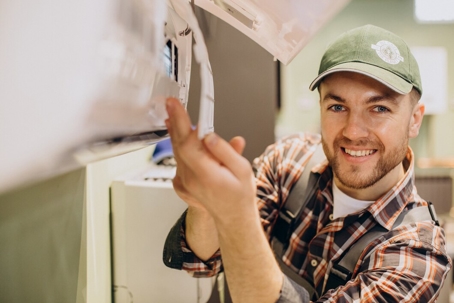For Whitchurch-Stouffville residents, a well-functioning air conditioning (AC) system is vital for maintaining home comfort during the warm summer months. If you’re considering installing a new AC system, knowing the overall installation process is crucial to ensure that your cooling system operates efficiently and provides long-lasting comfort.
Get a comprehensive step-by-step guide to the AC installation process. Marx Mechanical Heating and Cooling’s insights will help you understand the various stages involved in AC installation, ensure that key considerations are met, and ultimately result in a smooth and successful installation experience for your Whitchurch-Stouffville home.
1. Initial Assessment and Load Calculation
The first step in the AC installation process is to perform an initial assessment of your home, which includes evaluating your existing system, measuring the living space, and analyzing the layout for optimal AC installation. We’ll also perform a load calculation by assessing factors such as insulation levels, window sizes, and home orientation to determine the appropriate size of the AC system that will effectively and efficiently cool your home.
2. Choosing the Right AC System
Next, based on the initial assessment and load calculation, we’ll help you select the right type of AC system for your home. There are various factors to consider when choosing an AC unit, such as energy efficiency, cooling capacity, and noise levels. We’ll provide insightful recommendations that cater to your preferences and needs, ensuring you choose a system that best meets your requirements and budget.
3. Preparing Your Home
Before installing the new AC system, you must prepare your home. This involves:
- Checking and, if needed, upgrading the electrical system to ensure it can handle the additional load of the new AC unit.
- Inspecting and sealing the ductwork to prevent air leaks can impact efficiency and comfort.
- Creating adequate space for the indoor unit installation, including clearing the area around the location where the unit will be installed.
- Preparing the outdoor unit installation site by ensuring it is level, free of debris, and has proper drainage.
4. Installing the Indoor Unit
During this stage, our technicians will begin installing the indoor unit, following a series of steps:
- Safely mounting the indoor unit to the wall or ceiling, depending on the type of system chosen.
- Drilling a hole through the wall for refrigerant lines, electrical connections, and condensate drain lines.
- Connecting the refrigerant lines, which requires careful attention to avoid any leaks or damage.
- Ensuring proper sealing of the hole with insulation to prevent drafts, insects, or other issues.
5. Installing the Outdoor Unit
The outdoor unit, also known as the condenser, will be installed following these essential steps:
- Placing the outdoor unit on a level surface or a specially designed pad to ensure proper drainage and optimal performance.
- Connecting the refrigerant lines from the indoor unit to the outdoor unit, ensuring they are secure and leak-free.
- Connecting electrical wiring and implementing safety features such as a disconnect switch for the outdoor unit.
- Charging the system with refrigerant as per the manufacturer’s specifications.
6. Testing and Fine-Tuning the System
Once both the indoor and outdoor units are installed, our technicians will thoroughly test the AC system to ensure proper performance. This includes:
- Verifying proper airflow through the ducts and vents, adjusting as necessary.
- Testing the system’s cooling capabilities by monitoring temperature differential and making any required adjustments.
- Assessing the refrigerant levels and pressure to ensure they meet manufacturer specifications and adjusting them if needed.
- Inspecting the electrical connections to ensure safety and efficiency.
7. Insulating and Sealing Ductwork
To maximize AC system efficiency and home comfort, our team will inspect and seal the ductwork. Sealing gaps or leaks in the ducts not only helps maintain consistent temperatures throughout your home but also reduces energy consumption and prevents the infiltration of dust and allergens.
8. Installing Programmable Thermostats
To maximize comfort and energy efficiency, we recommend installing a programmable thermostat. These thermostats enable you to set temperature schedules based on your daily routines, ensuring optimal comfort while conserving energy during unoccupied or low-use periods. Our technicians will install and configure the thermostat, providing a brief tutorial on its features and operation.
9. Post-Installation Cleanup and Walkthrough
Upon completing the AC installation, our technicians will clean the work area, dispose of any debris, and ensure your home is in the same condition as it was before the installation began. We’ll also provide a thorough post-installation walkthrough, explaining how your new system works, outlining any maintenance requirements, and answering any questions you may have.
Trust the AC Installation Process to the Experts
Understanding the step-by-step AC installation process enables you to ensure that your new cooling system is installed correctly and efficiently, providing reliable comfort throughout the hot summer months.
At Marx Mechanical Heating and Cooling, our trained and experienced technicians guide you through each phase of the air conditioning installation, from initial assessment and system selection to post-installation inspection and walkthrough. Don’t take chances with an inexperienced installer or a poorly installed AC system. Contact our team of professionals today to get started on achieving optimal comfort and efficiency in your Whitchurch-Stoufville home with a stress-free AC installation experience that you can trust!

